
Farquhar Street is one of the older streets in George Town, with several examples of colonial British architecture in full glory. Seen here is the Supreme Court of Penang.
Farquhar Street, within George Town's UNESCO World Heritage Site, is one of the city's oldest streets. Located within the original settlement of George Town, it branches out of Northam Road, running along George Town's northern coast before joining up with Pitt Street to the east.
Along with Light Street, Farquhar Street forms part of the city's historic civic precint, with the Supreme Court of Penang located between both streets. Strong British influence can still be seen to this day; over the centuries, Anglican and Catholic churches, as well as five of Penang's missionary schools were built along this street.
Initially known as Penang Road, Farquhar Street was later named after one of the earlier Lieutenant-Governors of Penang. It was created as early as the late 18th. century, soon after the founding of George Town by Captain Francis Light.
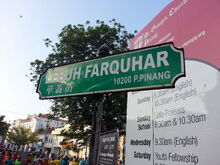
A bilingual Farquhar Street sign, featuring its Chinese name.
Etymology[]

Robert Townsend Farquhar (1776 - 1830), the second Lieutenant-Governor of the Prince of Wales Island.
At first, Farquhar Street was named Penang Road. It was later renamed Farquhar Street after Robert Townsend Farquhar (1776 - 1830), the second Lieutenant-Governor of the Prince of Wales Island (as Penang Island was then named).
During his term as the Lieutenant-Governor between 1804 and 1805, Farquhar recommended that the old entrepôt and city of Malacca should be abandoned and destroyed, in order to solidify the position of the newer British settlement of George Town. Malacca had been seized by the British East India Company from the Dutch, whose country was conquered by Napoleon's France. Thus, the fortifications of Malacca were to be destroyed to prevent the Dutch from regaining a strong Malacca. The task of demolishing A Famosa, the fort surrounding Malacca, fell into the hands of Farquhar's son, William.
However, the demolition of A Famosa was eventually halted by Sir Thomas Stamford Raffles, who would go on to found Singapore in 1819. By then, most of A Famosa had already been blown to dust, so only a small gate called Porta de Santiago was left standing.
Other than that, Farquhar undertook to improve the infrastructure of George Town. Fort Cornwallis was enlarged, the Government House was constructed and an open brick aqueduct was dug from the Penang Waterfall (now within Penang Botanic Gardens) to a reservoir located at Eastern & Oriental Hotel, right next to the sea.
The purpose of the aqueduct was to enable the selling of fresh water from Penang Hill to the ships anchored just off the Eastern & Oriental Hotel, also known as 'Sweet Water Bay'. However, the plan failed to come to a fruition, as vessels belonging to the Company could not be charged.
Nonetheless, by the time Farquhar left in 1805, even his critics had to contend that the infrastructure in George Town were much improved thanks to his efforts.
History[]
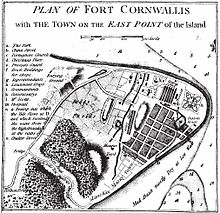
1798 Popham map of George Town
Farquhar Street was created towards the end of the 18th. century and appeared in the earliest maps of George Town. At the time, the street was named Penang Road. It was only renamed Farquhar Street after the term of Robert Townsend Farquhar as the Lieutenant-Governor between 1804 and 1805.

A 1921 postcard depicting the Supreme Court of Penang.
Farquhar Street gradually evolved to become a part of George Town's core civic precint. The Supreme Court of Penang was moved into the current premises between Farquhar Street and Light Street in 1809. Meanwhile, the Anglican St. George's Church was completed in 1818 at the eastern end of Farquhar Street (the junction with Pitt Street), where British administrators and Europeans resided at the time.

St. George's Church in the 19th. century.
Also at around the same time, Penang Free School, one of the premier English schools on Penang Island, was relocated to a spot immediately west of St. George's Church. Between 1896 and 1906, a new school building was constructed at the spot. However, Penang Free School was eventually shifted to its present premises at Green Lane in 1927, and the school building was then taken over by Hutchings School. Partly destroyed during the Second World War, the school building is now used as the Penang State Museum.
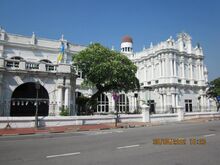
The Penang State Museum building once housed two missionary schools - Penang Free School and Hutchings School.

Farquhar Street in the 1910s, with the Church of the Assumption partially visible to the right.
While the Protestants had been firmly established around the eastern end of Farquhar Street, the Catholics came later towards the western side of the street. In 1857, the Church of the Assumption was relocated to its present site at Farquhar Street. In the same year, St. Xavier's Institution, Malaysia's oldest Catholic school, was also moved to its present premises immediately west of the Church of the Assumption. This was soon followed by Convent Light Street, which was shifted to the western end of Light Street, directly opposite St. Xavier's.
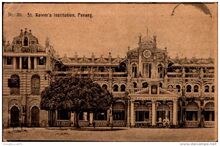
St. Xavier's Institution in the late 19th. century. Unfortunately, the school's impressive colonial architecture was lost for good, as a result of the aerial bombardment of George Town during World War 2.
At the western end of Farquhar Street, Mission Place was created by the Catholics towards the end of the 19th. century. In addition,St. George's Girls' School also came into being in 1885 along this section of Farquhar Street; it has since been relocated to its present compound at Macalister Road.

Eastern & Oriental Hotel, the most luxurious hotel in George Town.
In the 1880s, the Sarkies brothers built a handful of hotels near the western end of Farquhar Street. These hotels eventually became the Eastern & Oriental Hotel, one of the finest hotels in Southeast Asia. The Sarkies, having gained an extensive experience in the hospitality business, would go on to establish similar hotels across the region, including The Raffles Hotel in Singapore.
Notable Landmarks[]

Farquhar Mansion
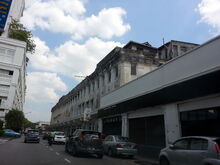
Lim Lean Teng Mansions at the western end of Farquhar Street

Mission House
From west to east :
- Lim Lean Teng Mansions
- Mission Place
- Mission House
- Farquhar Mansion
- The Garage
- Eastern & Oriental Hotel
- TPO Friendship Park
- St. Xavier's Institution
- Convent Light Street
- Church of the Assumption
- Penang State Museum
- Supreme Court of Penang
- St. George's Church


Educational Institutions[]
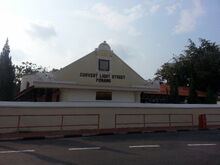
Convent Light Street, the oldest girls' school in Southeast Asia.
Out of the five missionary schools that used to be based at Farquhar Street, three remain today - St. Xavier's Institution, Convent Light Street and Hutchings School.
Convent Light Street, one of the several convent schools established across Penang Island, is the oldest girls' school in Southeast Asia. In the past, the school educated daughters of the wealthy and the royalties from abroad.

St. Xavier's Institution, the oldest Catholic school in Malaysia.
Unlike Convent Light Street, St. Xavier's Institution, the oldest Catholic school in Malaysia, did not retain its colonial architecture. The original school building that came with elements of Baroque style was destroyed by Allied bombers during World War 2. The building that you see now was more modern, completed in 1954.
Meanwhile, Hutchings School came into being when Penang Free School was being relocated to its present grounds at Green Lane. In 1919, a decision was made to rename the original school at Farquhar Street as Hutchings School, after the school's original founder. Hence, both Penang Free School and Hutchings School share a common heritage and history.
Today, these schools have been subsumed into the Malaysian national education system and utilise the standardised national high school syllabus.
Religion[]

St. George's Anglican Church, the oldest Anglican church in Southeast Asia.
Two churches - of opposing branches of Christianity - still stand along Farquhar Street.
At the eastern end of the street, St. George's Church, the oldest Anglican Church in Southeast Asia, has also become part of the 'Street of Harmony' along Pitt Street, sitting within metres of Muslim, Taoist and Hindu places of worship. It has also become a tourist attraction on its own right, a favourite for newly-weds seeking to take portraits of themselves with the impressive church architecture behind them.

The Church of the Assumption was founded by a French Catholic priest who led persecuted Eurasians to Penang Island under the invitation of Captain Francis Light.
Located next to St. Xavier's Institution, the Catholic Church of the Assumption once catered to the Eurasian community that used to reside within the vicinity. It also once served as the Cathedral for Penang Island as decreed by the Vatican, due to its central location. However, the city's dwindling population towards the end of the 20th. century caused it to lose its Cathedral status. A handful of Catholics from the shrinking Eurasian community still go to the church every Sunday.
Museum[]
The Penang State Museum, as its name implies, is a state museum describing the history of the State of Penang. It is a recommended place to start for those seeking to learn about the colonial beginnings of Penang Island, as well as the several cultures that traded along its shores.
The colonial building in which the museum is housed was once utilised by Penang Free School and its successor, Hutchings School. Having suffered considerable damage due to the aerial bombardment of George Town during the Second World War, the building was converted into the current museum in the 1960s by the Penang state government, with the agreement of Malaysia's then Prime Minister, Tunku Abdul Rahman, an alumnus of Penang Free School who wished to see the building preserved.
Food[]
- Farquhar Mansion
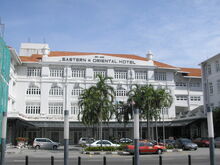
Eastern & Oriental Hotel, founded by the Sarkies brothers in the 1880s, remains the classiest hotel in George Town.
Hotels[]
- Eastern & Oriental Hotel
- Bayview Hotel
Political Representation[]
Penang State Government[]
N.26 Padang Kota State Assemblyman : Chow Kon Yeow (Democratic Action Party)
Malaysian Federal Parliament[]
P.049 Tanjong Member of Parliament : Ng Wei Aik (Democratic Action Party)
References[]
- Khoo S.N., 2007. Streets of George Town, Penang. Areca Books, Penang.
- Cheah J. S., 2013. Penang 500 Early Postcards. Editions Didier Millet.
- http://www.penang-traveltips.com/farquhar-street.htm
- http://wongchunwai.com/2013/01/alma-mater-right-smack-in-the-centre-of-historical-george-town/

